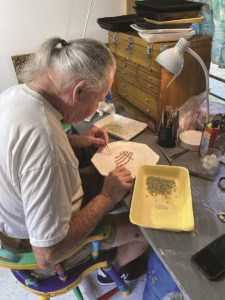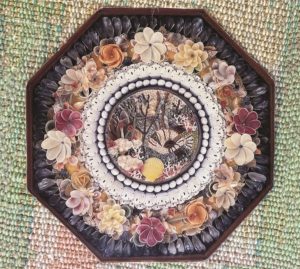Ever since Kevin Foley sailed the Wind Gypsy, his first charter boat, out of Wellfleet Harbor, he’s lived what he calls a nautical life. Foley — you may know him as “Foggy” — has captained sailboats of all sizes from Cape Cod to Key West to the Bahamas and back.

In his small trailer parked at Maurice’s Campground in South Wellfleet, Foley spends the summer working on Sailors’ Valentines. These aren’t the usual February poems or love letters, but compact mosaics made from small seashells. Legend has it that sailors made them on long voyages, but because of the delicacy of the work and the movement of sailing ships at sea, that is highly unlikely — although some may have been made by sailors during long periods on land when their ships were under repair.
Sailors’ Valentines were souvenirs made in Barbados — a frequent stop of whaling ships on their way home — and especially popular between the 1830s and ’90s. Mariners bought them there and brought them home to their families and sweethearts. Worked into their intricate shell patterns were sentimental words of love, longing, or friendship. They have been collected as folk art since the 1930s.
Foley first saw Sailors’ Valentines on a stop in Nantucket. They were on display at the Whaling Museum there. The Nantucket Historical Association keeps the tradition alive with classes. But Foley didn’t take a class; he just sailed away knowing he’d like to try his hand at the craft.
The Barbados artisans used octagonal Spanish cedar boxes as bases. That wood is hard to come by, but Foley, like most makers of Sailors’ Valentines today, still builds his pieces within octagonal frames, said to suggest the boxes that protected whaling ships’ compasses.
Traditional designs were symmetrical, with the shell patterns radiating out from a centerpiece — most often in the shape of a heart. But in the 1960s a few artisans began to make Sailors’ Valentines with new designs, and that’s Foley’s style, too.

When his daughter requested one with a lighthouse as the centerpiece, that set him on a path. Instead of an abstract pattern around the lighthouse, he produced a textured sky by crushing shells of varying shades of blue and mixing the pieces together. Nance Frank, the owner of the Gallery on Greene in Key West, Fla., told Foley the sky reminded her of Van Gogh.
Foley’s designs represent the places and people connected to his nautical life. He doesn’t draw a pattern out in advance for each mosaic. Instead, he marks the center point in the octagonal box and the top, then begins to build the centerpiece, working in words he has chosen, often from Jimmy Buffet songs — the singer gave him his personal permission, he says — and then, with the images of the places he wants to memorialize lodged firmly in his head, he ad libs the rest, adjusting for the resistance of the shells and the constricted space within the frame.

His latest Valentine, number 87, has the words “No Shoes, No Shirt, No Problem,” sentiments from a Kenny Chesney song, encircling the centerpiece. He dreams of one day building a six-foot-wide mosaic where schoolchildren would place shells in demarcated spaces. He also has more immediate plans tied to his Key West to Cape Cod trajectory: he wants to do a Gay Pride Sailors’ Valentine for his friend at the Gallery on Greene in Key West. And he wants to make another one, too, to auction off to help fund the restoration of the schooner Hindu in Provincetown.
While there may be a purist somewhere who uses only shells picked up personally on the beach to make Sailors’ Valentines, the only realistic way to acquire the variety of shells you need in size, shape, and color is to buy them from a shell shop. There happens to be one in Provincetown, on Commercial Street, conveniently located behind Cabot’s Candy.
Foley takes commissions on Sailor’s Valentines through Folly Cove Fine Art, a gallery on Main Street in Rockport — where they specialize in art from the “Cape Cod School.”
